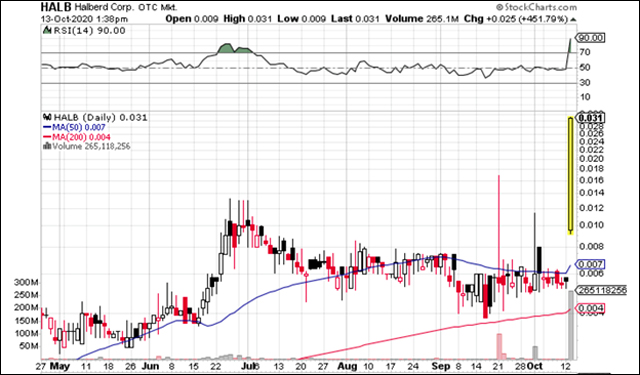The stock market is a burgeoning mix of opportunities. Extreme volatility tends to favor traders by presenting lucrative options to buy on the dip, and catch the wave on the way up. Anyone who’s ever watched Wall Street with Michael Douglas and Charlie Sheen, and the follow-up Wall Street: Money Never Sleeps, invariably becomes fascinated with the markets.

Timing is everything. If you call it right, it is possible to generate outsized returns without too much hassle. However, a caveat is in order: there is no substitute for practice, patience, and professionalism. The most successful traders understand that tremendous planning is required when compiling a profitable financial portfolio. Before we immerse ourselves in the above penny stock (HALB), it is worth understanding which market forces act on stocks to cause them to rise or fall accordingly.
Understanding Market Dynamics
The current economic paradigm is best described as precarious. The novel coronavirus has ravaged global markets, leaving a trail of devastation in its wake. We can extrapolate from real-life, knowing that every door that closes invariably results in another door opening. As a trader, it is important to dispense with traditional linear thinking. Investors make money by buying and holding financial instruments, waiting for appreciation.
This is a time intensive process, but it’s also extremely limiting, since your capital is tied up and out of commission. A day trader’s timeline is much shorter than that of an investor. Traders tend to buy and sell from minute to minute, while investors gravitate towards long-term holdings. It’s easy to understand that a trader could leverage the buying power of capital substantially more than an investor, in a fraction of the time.
Lesson #1. Investing is a passive vocation compared to trading which is an active vocation. Traders need to have their finger on the pulse at all times, lest they lose profitable trading opportunities. Investors don’t mind about market volatility too much, since they’re in it for the long haul. Here’s some free advice from the words of legendary investor Warren Buffett: Be fearful when other people are greedy, and greedy when other people fearful.
How to Understand the Potential Trading Value of a Penny Stock?
We are currently living through the most dangerous pandemic since the Spanish Flu in 1918-1920. With tens of millions of people infected with the novel coronavirus, and well over 1 million people dead, there is reason to be concerned. In times of crisis, the best of humanity steps up and makes a difference. As a trader, there is no harm in supporting these emerging companies, whether you short them, or you go long on them because you believe they have a value proposition. This leads us to an important lesson with regards to trading and profitability. You don’t need the underlying asset to appreciate in order to generate a favorable return from it.
Lesson #2. Trading profits can be generated on the upside, or downside of a financial instrument’s price. If your research leads you to believe that the future price of a stock will be less than the present price of a stock, you could short the stock. If your research leads you to believe that the future price of the stock will be greater than the present price of the stock, you buy the stock and hold the stock.
The difference between traditional stocks and penny stocks is substantial enough to warrant a definition of penny stocks. According to stock trader Timothy Sykes, penny stocks are defined as: ‘..stock trading for under $5 per share…Pennystocking is a unique style of trading that requires a specific strategy and mindset.”
So, we can broadly infer that the penny stock companies which offer their stocks for sale are not necessarily well established, and don’t have a proven track record, if at all. All that’s available is an idea, seed capital, and a degree of research which will likely [hopefully] translate into the development of a product, or service.
One such stock which exploded out of the blocks on October 13, 2020 was HALB. Alaric Corporation (HALB) has a market capitalization of $9.716 million, and a price/earnings ratio of 11.60. The company’s stock is trading at $0.0338 per share, up 503.5714% on the day. HALB rallied heavily on the news that Halberd Corporation (OTC PINK: HALB) was successful in the development of an ‘anti-Spike protein monoclonal antibody against Covid-19.’ At a time where millions of people are infected, and well over 1 million people have already died, such news has a massive upswing effect on investors and traders.
This particular company has already filed for patent protection, for its therapeutic/vaccine which has a 3-fold benefit, including diagnostic, preventative, and therapeutic treatments. Naturally, everyone piled into the stock on the day, realizing a 500% gain from under $0.01 per share to its current price. Those who rode the wave early on enjoyed maximum benefit from the stock’s appreciation.
Unfortunately, timing is everything with stocks trading. Once news of the massive spike broke, many novice traders [late to market traders] expected the rally to continue. By buying in after the stock has reached its apex for the day, there is nowhere left to go but down, given all the profit-taking that has already taken place. This leads to the most important lesson of the day.
Lesson #3. ‘Value your education, ignore those who don’t value education they’re lost in life and there’s no helping them, due to their own laziness/stubbornness.’ Top-tier stocks trading academies present students with comprehensive trading materials, market analysis, and in-depth insights to better understand the financial markets, economic indicators, and the signals which traders must be made aware of. This type of education can take months, perhaps even years to master. The mark of a successful trader is not necessarily somebody who gets lucky on a couple of trades; it’s a trader who understands where he/she went wrong, and how to correct those errors.

 Hot Features
Hot Features













